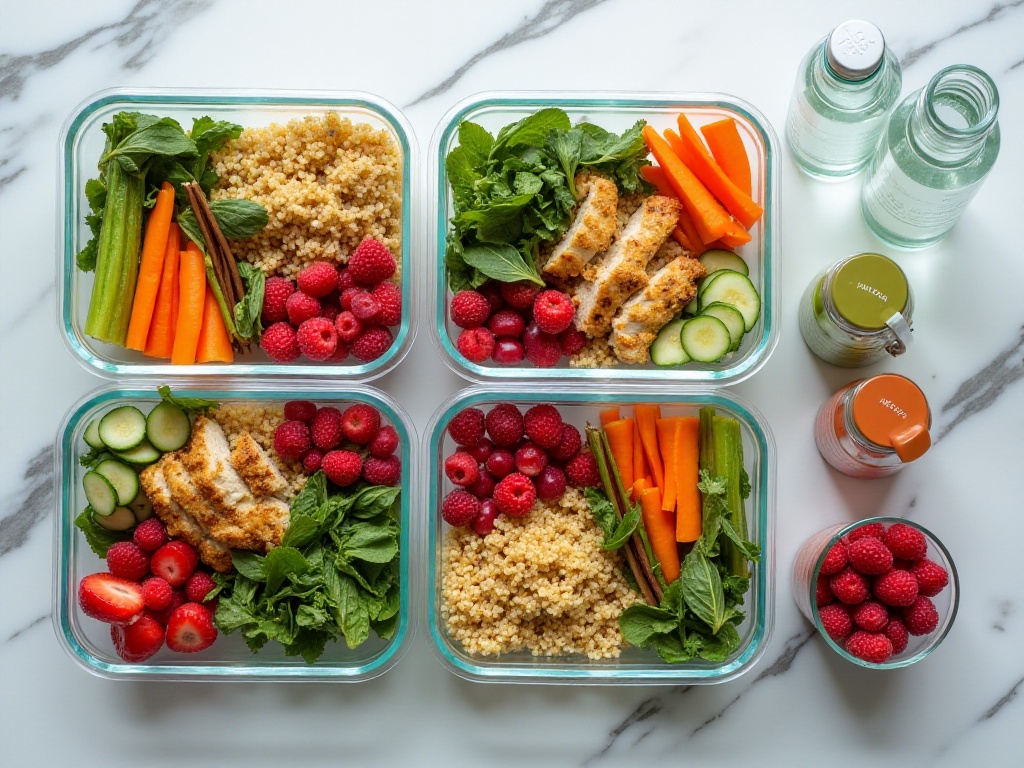Introduction
Recently while scrolling through short videos, I've been bombarded with various "healthy eating" content - from keto diets to intermittent fasting to low-carb diets... it's really overwhelming. Nutritionists say eat less of this, more of that, with all kinds of different advice, leaving me confused about whom to listen to. But later I discovered that healthy eating isn't actually that complicated - the key is finding what works for you. Today I'd like to share my insights on how to eat healthily without too much hassle.
The Rainbow Plate
To be honest, when I first started learning about healthy eating, I was completely lost. Then one day, I came across the concept of the "rainbow plate" on social media and was instantly captivated. The idea is that our plates should be as colorful as a rainbow. Think about it - bright red tomatoes, orange carrots, verdant broccoli, deep purple eggplants... each color of food contains different nutritional "treasures," and the more diverse the combination, the more comprehensive the nutrition.
I remember when I first tried this approach, every trip to the market felt like a treasure hunt, looking for vegetables and fruits of different colors. Red peppers rich in vitamin C, orange pumpkins full of beta-carotene, green choy sum providing folate and iron, purple grapes packed with anthocyanins... gradually, I found myself developing a deeper understanding of ingredients and making food selection more interesting.
I remember once buying red, yellow, and green peppers to stir-fry together - not only did it look beautiful, but the textures were also distinctly layered. The red peppers were sweet and crispy, the yellow ones refreshingly sweet, and the green ones slightly spicy - the perfect combination made this dish one of my specialties. When friends came over, they were amazed by my "rainbow stir-fry," saying they never thought healthy eating could look so appealing.
Now whenever I prepare meals, I automatically check the color combination. Breakfast might be golden fried eggs with purple blueberries, lunch could be emerald broccoli with red salmon slices, and dinner might be a colorful mixed salad. This not only makes the plate look appetizing but more importantly ensures balanced nutrition.
I've also noticed an interesting phenomenon: since I started paying attention to the color combinations on my plate, my desire for junk food has actually decreased. Maybe seeing colorful healthy food makes me feel happier. Plus, different colored ingredients often mean different textures and flavors, making eating more interesting.
Nutritional Foundations
Protein Supplementation
When it comes to nutrition, protein is absolutely crucial. I used to think protein supplementation just meant eating meat, but now I know protein sources are much more diverse. Soy products, eggs, fish, and even some grains and nuts contain significant protein.
I remember once specifically researching protein content in different foods and discovered that a boiled egg contains 6-7 grams of protein, 100 grams of tofu provides about 8 grams of protein, and a can of tuna can provide 20 grams of protein. These figures gave me a clearer understanding of daily dietary planning.
Now my office drawer always has some ready-to-eat protein sources like boiled eggs, nuts, and canned tuna. This way, even during short lunch breaks, I can quickly get quality protein. Plus, these foods are very convenient to store without worrying about spoilage.
I've also learned some protein pairing tricks. For example, combining soy products with grains can be complementary, like a bowl of preserved egg porridge with a side of cold tofu makes a good protein combination. Or mixing shredded chicken breast with quinoa in a salad is both delicious and nutritious.

Healthy Fats
When it comes to fat, many people's first reaction is "fattening." This is actually a misconception - healthy fats not only won't make you fat but are actually very important for your body. Take Omega-3 fatty acids for example, they're like "lubricant" for various body systems, important for cardiovascular health and eye function.
Now I eat fish 2-3 times a week, and it doesn't have to be expensive salmon - mackerel and sardines are affordable fish with high nutritional value. These fish are very versatile too - they can be fried, grilled, or made into soup, and they're delicious any way you cook them.
Besides fish, I particularly like using olive oil. I use it for both cold dishes and stir-frying. Recently I also learned to make breakfast with avocados - sliced on whole wheat bread with some black pepper, it's absolutely delicious.
As for nuts, I now eat a small handful of mixed nuts every day. Peanuts, walnuts, almonds, cashews - each has different nutritional components. Since nuts are relatively high in calories, I pre-portion them into small packages and eat just one package per day, so I can supplement healthy fats without consuming too many calories.

Smart Eating Methods
Advance Preparation
As the saying goes, "Good tools are prerequisite to the successful execution of a job." The most important aspect of healthy eating is preparation. I've learned this lesson the hard way too many times. Like working late, being starving, with only convenience stores open nearby, ending up having to make do with some snacks. So now I particularly focus on advance preparation.
Every weekend, I spend some time doing a "mini" food prep. Washing and cutting fruits into small containers, cooking a pot of whole grain rice to portion and freeze, preparing some ready-to-eat healthy snacks. This way, no matter how busy I get, I can ensure basic nutrition.
My fridge now always has some "emergency ingredients." Frozen dumplings (preferably whole wheat or vegetable filling), boiled eggs, ready-to-eat salads, energy bars, etc. While these foods might not be the ideal choice, they're much healthier than junk food.
Particularly worth mentioning is that I've developed a habit of carrying fruit with me. Every morning before leaving home, I'll take an apple or banana, so when I'm hungry in the afternoon, I have a healthy option. Plus, the natural sweetness of fruit can help satisfy cravings for sweets.

Snack Transformation
Honestly, giving up snacks is really hard, but transforming snacks is quite easy. My current strategy is: keep healthy snacks in plain sight and hide less healthy snacks where they can't be seen.
For example, I always have a plate of fruit on my desk and portioned nuts in my drawer. When I want to snack, these healthy options are the first things I see. Chips and cookies - these high-calorie snacks are hidden on high shelves where I need a stool to reach them, giving myself more time to think.
I also particularly enjoy making some healthy snacks. Like drying fruit slices into fruit chips, or mixing nuts and oats to make energy bars. These snacks are not only healthy but also satisfy cravings.
Recently I've discovered an interesting phenomenon - drinking water can also help curb snack cravings. So now I always keep a large water bottle on my desk and take sips regularly. It not only maintains hydration, but sometimes when you feel hungry, you might just be thirsty.

Family Dietary Revolution

All Family Members Involved
The hardest part of healthy eating might be persistence, but if you can turn it into a family activity, it becomes much more fun. Now our family often goes to the market together on weekends, with everyone responsible for selecting different ingredients, like a treasure hunt game.
Particularly interesting is the change in my young nephew. He used to have no interest in vegetables, but now we've planted a small garden on the balcony with cherry tomatoes, lettuce, herbs, and so on. He's responsible for watering and observing, and now he's very enthusiastic, checking the plants' growth several times a day. Most amazingly, he's started eating the vegetables he grows himself, and he treasures them so much he's reluctant to share with others.
We also research new recipes together. Every weekend we take turns deciding what new dish to make, then prepare ingredients and cook together. This process not only strengthens relationships but also teaches cooking skills. Moreover, home-cooked meals are often healthier than takeout because we can control the amount of oil and salt.
To make healthy eating more interesting, we also hold "creative cooking competitions." The rules are simple - make dishes that are both attractive and delicious using healthy ingredients. Last time my brother made a "garden salad" using carrots and cucumbers cut into flower shapes with yogurt, which received unanimous praise from the whole family.
New Dietary Ideas
To keep healthy eating from becoming monotonous, I often try new cooking methods. Like using an air fryer instead of deep frying, using herbs and natural seasonings instead of excessive salt, using fruits to make natural desserts.
Recently, one of my favorite approaches is "one theme per week." For example, this week might focus on Mediterranean style, so we eat more fish, olive oil, vegetables, and legumes; next week might switch to Asian style, with lots of soy products and seafood. This way we can try different cuisines while ensuring nutritional balance.
I've also learned many ingredient substitution tricks. Like using yogurt instead of mayonnaise for salad dressing, using whole wheat bread instead of white bread, using sweet potato puree to replace part of the sugar and oil in cakes. These small changes don't affect the taste much but make food healthier.
To get children to love healthy food, we make food particularly interesting. Like making fruit into animal shapes, cutting sandwiches into their favorite cartoon character shapes, calling vegetable soup "magic soup." These little creative touches make healthy eating more fun.
Final Thoughts
Honestly, when I first started changing my eating habits, I experienced many failures too. Sometimes when busy I would forget to prepare healthy food, sometimes I couldn't resist tempting junk food. But the most important thing is not to give up because of temporary setbacks. Healthy eating is a gradual process that requires slowly developing habits.
Looking back now, although changing eating habits was indeed a bit difficult at first, it was really worth persisting. Not only is my body healthier, but my mood has improved too. Moreover, through researching and trying various healthy ingredients, I've discovered many delicious new combinations that have made my diet more colorful and diverse.
Finally, I want to say that there's no fixed standard for healthy eating - what's important is finding what works for you. You can start with small changes and gradually build healthy eating habits. I believe that through continuous effort, you'll definitely find your own path to healthy eating.
How do you arrange your daily diet? Do you have any unique healthy eating tips you'd like to share? Welcome to tell me in the comments section, let's learn from each other and progress together on the path to healthy eating.







